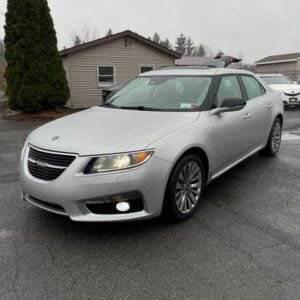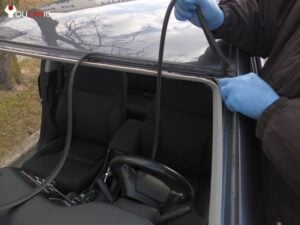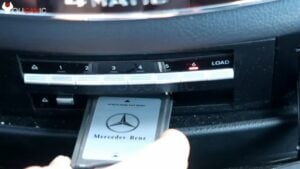Mercedes SBC Brake Counter Reset Code C249F
Mercedes SBC brakes utilize an electronic control unit that regulates the brake pressure in each wheel on models such as E Class W211, SL-Class R230, and CLS-Class. This system includes a counter that tracks the number of times the brakes are applied. Once the counter reaches a certain threshold, the driver will see a “STOP” red light on the dashboard, indicating a brake malfunction. At this point, the brake pedal may become difficult to press, and the driver should have the SBC system inspected by a qualified technician to diagnose the issue.
The counter is designed to ensure that the SBC system and brake components are not overused, which helps extend their lifespan and maintain the vehicle’s safety. The hydraulic unit component of the SBC traction system has exceeded its operating time limit. Mercedes-Benz has established a cycle limit for the SBC hydraulic pump. Once the SBC module count goes from 300,000 to 0, the instrument cluster will display one of the following errors:
• STOP VEHICLE
• SBC Control Module Failure
• REDUCED BRAKING POWER – VISIT WORKSHOP
• Brake Defective Stop Vehicle
Troubleshooting Mercedes SBC Brake Counter Reset
The video below demonstrates the process for resetting the counter on Mercedes-Benz SBC brakes with YOUCANIC Scanner. It is essential to note that this procedure should only be performed on a rebuilt SBC pump or if the SBC has been replaced. Attempting to reset the SBC counter on a used pump that hasn’t been rebuilt could result in brake failure while driving, creating a potentially dangerous situation.
What happens when SBC fails?

Mercedes SBC brakes are designed to provide reliable and efficient braking under normal driving conditions. However, if the SBC system fails, it can result in serious safety issues while driving. For instance, if there is a total failure of the SBC system, the braking efficiency during emergencies will be severely reduced, which could lead to longer stopping distances and increased risk of collisions.
In addition, a total failure of the SBC system may also result in a complete loss of brakes, which can be a catastrophic situation. The driver may experience a sudden and unexpected loss of braking power, making it difficult or impossible to stop the vehicle. This can be especially dangerous when driving at high speeds or in heavy traffic, where quick and precise braking is necessary to avoid accidents.
It’s important to note that regular maintenance and inspection of the SBC system can help prevent these situations from occurring. It’s recommended to have the SBC system inspected and serviced by a qualified technician at the recommended intervals specified by the manufacturer. This will help ensure that the SBC system functions correctly and that any potential issues are identified and addressed promptly.
Symptoms
- C249F & C2498 – The operating time of the SBC Traction system hydraulic unit’s (A7/3) component has been exceeded.
- STOP VEHICLE – REDUCED BRAKING POWER – VISIT WORKSHOP Brake Defective Stop Vehicle
- C26DE/ C26BB Hydraulic Fault -SBC Control Module Failure –
- Brake Red Light, On Dash
- The brake pedal is too hard to press
Common Causes
SBC Counter Limit Reached:
The hydraulic unit component of the SBC traction system has exceeded its operating time limit. Mercedes-Benz has established a cycle limit for the SBC hydraulic pump. Once the SBC module count reaches around 300,000, the instrument cluster will display one of the following errors: STOP VEHICLE, SBC Control Module Failure, REDUCED BRAKING POWER – VISIT WORKSHOP and Brake Defective Stop Vehicle.
SBC Pump Defective:
The SBC/Electro-Hydraulic Brake System Hydraulic Pump can be severely damaged, reducing braking power or even a complete loss of braking capability. This component is responsible for creating and applying pressure to the brakes. The SBC error code is commonly seen in Mercedes-Benz cars, such as the E-Class W211, SL-Class (R230), and CLS-Class. If the SBC pump is defective, it can cause significant safety concerns, and immediate attention should be given.
Brake Light Switch

A failing brake light switch can have various symptoms, and one of the most noticeable is when the brake light remains illuminated at all times. This issue often occurs due to a short circuit in the brake light switch, which can cause the brake lights to stay on even when the pedal is not being pressed. Over time, this can lead to the brake lights burning out and needing replacement.
Weak Car Battery:

When a car battery becomes weak, it can cause several issues with the vehicle’s electrical systems, including the SBC brake system. If the SBC control module fails to receive enough voltage from the battery, it can trigger warning messages such as “REDUCED BRAKING POWER – VISIT WORKSHOP” or “Brake Defective Stop Vehicle.” This is because the SBC pump, which creates pressure for the brakes, does not have enough voltage to power up, resulting in reduced or complete loss of braking power. If you experience any warning messages, it’s important to address them immediately and have the SBC system checked by a qualified mechanic.
Extended Warranty
The Sensotronic Brake Control (SBC) system was installed on some models from 2003 to 2006, and it has been known to have issues with its pump, which could cause the brakes to fail.
In response to these issues, Mercedes-Benz offered an extended warranty on the SBC system for up to 25 years or 250,000 miles from the original in-service date, whichever comes first.
Suppose you are experiencing issues with your SBC system. In that case, you should contact your local Mercedes-Benz dealership or authorized repair center to see if your vehicle qualifies for the extended warranty.








